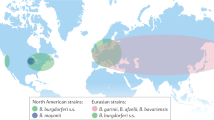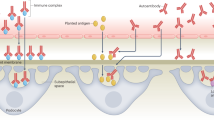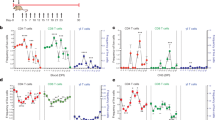Abstract
Autoimmune diseases remain one of the mysteries that perplex immunologists. What makes the immune system, which has evolved to protect an organism from foreign invaders, turn on the organism itself? A popular answer to this question involves the lymphoid network's primordial function: autoimmunity is a by-product of the immune response to microbial infection. For decades there have been tantalizing associations between infectious agents and autoimmunity: β-hemolytic streptococci and rheumatic fever; B3 Coxsackieviruses and myocarditis; Trypanosoma cruzi and Chagas' disease; diverse viruses and multiple sclerosis; Borrelia burgdorfii and Lyme arthritis; and B4 Coxsackievirus, cytomegalovirus or rubella and type 1 diabetes, to name the most frequently cited examples1. In addition, animal models have provided direct evidence that infection with a particular microbe can incite a particular autoimmune disease2. Nonetheless, many of the associations appear less than convincing and, even for those that seem to be on solid footing, there is no real understanding of the underlying mechanism(s).
This is a preview of subscription content, access via your institution
Access options
Subscribe to this journal
Receive 12 print issues and online access
$209.00 per year
only $17.42 per issue
Buy this article
- Purchase on Springer Link
- Instant access to full article PDF
Prices may be subject to local taxes which are calculated during checkout

Bob Crimi
Similar content being viewed by others
References
Rose, N. R. & Mackay, I. R. Molecular mimicry: a critical look at exemplary instances in human diseases. Cell. Mol. Life Sci. 57, 542–551 (2000).
Lawson, C. M. Evidence for mimicry by viral antigens in animal models of autoimmune disease including myocarditis. Cell. Mol. Life Sci. 57, 552–560 (2000).
Wucherpfennig, K. W. Structural basis of molecular mimicry. J. Autoimmun. 16, 293–302 (2001).
Maverakis, E., van den Elzen, P. & Sercarz, E. E. Self-reactive T cells and degeneracy of T cell recognition: evolving concepts from sequence homology to shape mimicry and TCR flexibility. J. Autoimmun. 16, 201–209 (2001).
Rose, N. R. & Bona, C. Defining criteria for autoimmune diseases (Witebsky's postulates revisited). Immunol. Today 14, 426–430 (1993).
Fujinami, R. S. Can virus infections trigger autoimmune disease? J. Autoimmun. 16, 229–234 (2001).
Fairweather, D., Kaya, Z., Shellam, G. R., Lawson, C. M. & Rose, N. R. From infection to autoimmunity. J. Autoimmun. 16, 175–186 (2001).
Maier, B. et al. Multiple cross-reactive self–ligands for Borrelia burgdorferi-specific HLA-DR4-restricted T cells. Eur. J. Immunol. 30, 448–457 (2000).
Hemmer, B. et al. Identification of candidate T-cell epitopes and molecular mimics in chronic Lyme disease. Nature Med. 5, 1375–1382 (1999).
Wucherpfennig, K. W. Structural basis of molecular mimicry. J. Autoimmun. 16, 293–302 (2001).
Maverakis, E., van den Elzen, P. & Sercarz, E. Self-reactive T cells and degeneracy of T cell recognition: evolving concepts-from sequence homology to shape mimicry and TCR flexiblity. J. Autoimmun. 16, 201–209 (2001).
Martin, R. et al. Molecular mimicry and antigen-specific T cell responses in multiple sclerosis and chronic CNS lyme disease. J. Autoimmun. 16, 187–192 (2001).
Steere, A.C., Gross, D., Meyer, A. L. & Huber, B. T. Autoimmune mechanisms in antibiotic treatment-resistant Lyme arthritis. J. Autoimmun. 16, 263–268 (2001).
Sigal, L. Lyme arthritis: lessons learned and to be learned. Arthritis Rheum. 42, 1809–1812 (1999).
Steere, A. C. & Baxter-Lowe, L. A. Association of chronic, treatment-resistant Lyme arthritis with rheumatoid arthritis (RA) alleles. Arthritis Rheum. 41, S81 (1998).
Kalish, R. A., Leong, J. M. & Steere, A. C. Association of treatment-resistant chronic Lyme arthritis with HLA-DR4 and antibody reactivity to OspA and OspB of Borrelia bugdorferi. Infect. Immun. 61, 2774–2779 (1993).
Kalish, R. A., Leong, J. M. & Steere, A. C. Early and late antibody responses to full-length and truncated constructs of outer surface protein A of Borrelia burgdorferi in Lyme disease. Infect. Immun. 63, 2228–2235 (1995).
Lengl-Janssen, B., Strauss, A. F., Steere, A. C. & Kamradt, T. The T helper cell response in Lyme arthritis: differential recognition of Borrelia burgdorferi outer surface protein A (OspA) in patients with treatment-resistant or treatment-responsive Lyme arthritis. J. Exp. Med. 180, 2069–2078 (1994).
Gross, D. M., Steere, A. C. & Huber, B. T. T helper 1 response is dominant and localized to the synovial fluid in patients with Lyme arthritis. J. Immunol. 160, 1022–1028 (1998).
Yssel, H. et al. Borrelia burgdorferi activates a T helper type 1-like T cell subset in Lyme arthritis. J. Exp. Med. 174, 593–601 (1991).
Sigal, L. H. et al. A vaccine consisting of recombinant Borrelia burgdorferi outer-surface protein A to prevent Lyme disease. N. Engl. J. Med. 339, 216–222 (1998).
Steere, A. C. et al. Vaccination against Lyme disease with recombinant Borrelia burgdorferi outer-surface lipoprotein A with adjuvant. N. Engl. J. Med. 339, 209–215 (1998).
Gross, D. M. et al. Identification of LFA-1 as a candidate autoantigen in treatment-resistant Lyme arthritis. Science 281, 703–706 (1998).
Hammer, J. et al. Precise prediction of major histocompatibility complex class II-peptide interaction based on peptide side chain scanning. J. Exp. Med. 180, 2353–2358 (1994).
Chen, J. et al. Association of antibiotic treatment-resistant Lyme arthritis with T cell responses to dominant epitopes of outer surface protein A of Borrelia burgdorferi. Arthritis Rheum. 42, 1813–1822 (1999).
Meyer, A. L. et al. Direct enumeration of Borrelia-reactive CD4 T cells ex vivo by using MHC class II tetramers. Proc. Natl Acad. Sci. USA 97, 11433–11438 (2000).
Trollmo, C., Meyer, A. L., Steere, A. C., Hafler, D. A. & Huber, B. T. Molecular mimicry in Lyme arthritis demonstrated at the single cell level: LFA-1αL is a partial agonist for outer surface protein A–reactive T cells. J. Immunol. 166, 5286–5291 (2001).
Akin, E., Aversa, J. & Steere, A. C. Expression of adhesion molecules in synovia of patients with treatment-resistant Lyme arthritis. Infect. Immun. 69, 1774–1780 (2001).
Gross, D. M. & Huber, B. T. Cellular and molecular aspects of Lyme arthritis. Cell. Mol. Life Sci. 57, 1562–1569 (2000).
Korganow, A.-S. et al. From systemic T cell self-reactivity to organ-specific autoimmune disease via immunoglobulins. Immunity 10, 451–461 (1999).
Keffer, J. et al. Transgenic mice expressing human tumour necrosis factor: a predictive genetic model of arthritis. EMBO J. 10, 4025–4031 (1991).
Streilein, J. W., Dana, M. R. & Ksander, B. R. Immunity causing blindness: five different paths to herpes stromal deratitis. Immunol. Today 18, 443–449 (1997).
Panoutsakopoulou, V. & Cantor, H. On the relationship between viral infection and autoimmunity. J. Autoimmun. 16, 341–345 (2001).
Kanangat, S., Thomas, J., Gangappa, S., Babu, J. S. & Rouse, B.T. Herpes simplex virus type I-mediated up-regulation of IL-12 (p40) mRNA expression. J. Immunol. 156, 1110–1116 (1996).
Opremcak, E. M. et al. Immunogenetic influence of IgH-1 phenotype on experimental herpes simplex virus type-1 corneal infection. Invest. Opthalmol. Vis. Sci. 29, 749–754 (1988).
Dutt, J. E., Riblet, R. & Foster, C. S. The influence of Igh-C linked loci on murine herpes keratitis. Invest. Opthalmol. Vis. Sci. 34, 1347–1347 (1993).
Foster, C. S. et al. Clinical, pathologic and immunopathologic characteristics of experimental murine herpes simplex virus stromal keratitis and uveitis is controlled by gene products from the Igh-1 locus on chromosome 12. Trans. Am. Ophthalmol. Soc. 85, 293–311 (1987).
Opremcak, E. M., Rice, B. A., Wells, P. A. & Foster, C. S. Histology and immunohistology of Igh-1-restricted herpes simplex keratitis in BALB/c congenic mice. Invest. Opthalmol. Vis. Sci. 31, 305–312 (1990).
Avery, A. C. et al. Resistance to herpes stromal keratits conferred by an IgG2a-derived peptide. Nature 376, 431–434 (1995).
Zhao, Z.-S., Granucci, F., Yeh, L., Schaffer, P. A. & Cantor, H. Molecular mimicry by herpes simplex virus-type 1: autoimmune disease after viral infection. Science 279, 1344–1347 (1998).
Gangappa, S., Deshpande, S. P. & Rouse, B. T. Bystander activation of CD4+ T cells accounts for herpetic ocular lesions. Invest. Opthalmol. Vis. Sci. 41, 453–459 (2000).
Deshpande, S. P. et al. Herpes simplex virsu-induced keratitus: evaluation of the role of molecular mimicry in lesion pathogenesis. J. Virol. 75, 3077–3088 (2001).
Panoutsakopoulou, V. et al. Analysis of the relationship between viral infection and autoimmune disease. Immunity 15, 137–147 (2001).
Author information
Authors and Affiliations
Corresponding author
Rights and permissions
About this article
Cite this article
Benoist, C., Mathis, D. Autoimmunity provoked by infection: how good is the case for T cell epitope mimicry?. Nat Immunol 2, 797–801 (2001). https://doi.org/10.1038/ni0901-797
Issue Date:
DOI: https://doi.org/10.1038/ni0901-797
This article is cited by
-
BCG immunization induces CX3CR1hi effector memory T cells to provide cross-protection via IFN-γ-mediated trained immunity
Nature Immunology (2024)
-
Complex regulatory effects of gut microbial short-chain fatty acids on immune tolerance and autoimmunity
Cellular & Molecular Immunology (2023)
-
The year that shaped the outcome of the OspA vaccine for human Lyme disease
npj Vaccines (2022)
-
Seroprevalence of Toxoplasma gondii among a group of Egyptian patients with type I diabetes mellitus
Bulletin of the National Research Centre (2019)
-
Ocular antigen does not cause disease unless presented in the context of inflammation
Scientific Reports (2017)



